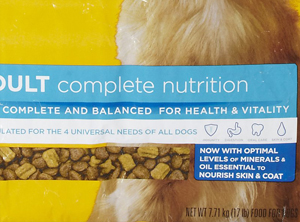|
 EU law defines a complete pet food as "any food which, by reason of its composition, is sufficient for a daily ration" and defines a daily ration as "The average total quantity of a specific pet food that is needed daily by a pet of a given species, age category and life style or activity to satisfy all its energy and nutrient requirements". EU law defines a complete pet food as "any food which, by reason of its composition, is sufficient for a daily ration" and defines a daily ration as "The average total quantity of a specific pet food that is needed daily by a pet of a given species, age category and life style or activity to satisfy all its energy and nutrient requirements".
In theory, this means you can rest assured that any food you find labelled as 'complete' has everything your dog needs to stay fit and healthy. Since most manufacturers recommend feeding only their foods, the principal of dietary 'completeness' is absolutely central to pet health and yet it is exactly this premise that is drawing increasing amounts of criticism from certain parts of the pet community.
The main critisism is levelled at the recommended nutrient requirements themselves. In Europe, the nutritional guidelines are set by the European Pet Food Industry Federation (FEDIAF) who's other job it is to represent the interests of European pet food manufacturers. Their recommended nutritional levels are based on "scientific studies (including NRC 2006) and unpublished data from the industry". Investigations by the Association for Truth in Pet Food reveal that the NRC (National Research Council in the US) itself has extremely strong ties with just about all of the large pet food corporations which means that, essentially, the established pet food industry is setting its own rules. With such a clear conflict of interest, many have suggested that their advice might be more about protecting their interests and the status-quo rather than pursuing nutritional excellence.
For example, could it simply be coincidence that FEDIAF's recommended protein level for adult dogs of 18% dry matter just happens to be consistent with the low-meat, high-carb diets that their biggest members churn out?
Then there's the question of nutrient quality. It is now becoming more and more clear that the source and grade of ingredients and the nutrients they contain (proteins from fresh meats vs proteins form vegetable derivatives, for example) are absolutely paramount to assessing food quality and yet the recommended nutrient levels for complete foods do not even approach the subject. Again, this plays directly into the hands of the manufacturers of low grade pet foods.
Furthermore, the FEDIAF minimum vitamin and mineral levels basically necessitate the use of a synthetic multivitamin & mineral premix. These white powders are basically the equivalent of the multivitamin tablets taken by people and they are added to virtually all complete pet foods on a global scale. They are not in themselves a bad thing but they do make it much easier for companies to use sub standard, nutritionally deficient ingredients in the knowledge that the premix will bump them up to the minimal levels regardless. They are also synthetic (i.e. not natural) which has led some more natural brands and particularly raw producers to omit them from their foods in favour of focussing on the natural nutrients contained in the raw ingredients. By law these foods should not be called 'complete' (although some producers still use te term).
For us pet owners, this creates the impossible task of choosing between foods that are certified nutritionally complete under a highly flawed scheme and that are not entirely natural OR totally natural foods that alone probably don't provide everything a dog needs.
In short, the current complete food guidelines are a total mess and desperately need a full and impartial overhaul... but right now they are all we have. Whether you choose to go with a FEDIAF compliant food or not is up to you - there are good and bad examples of both. Our advice, as always, is to look for a food with a high nutritional rating that suits your dog and to shore up any potential nutritional deficiencies by simply mixing things up now and then. Mixing or alternating between two or more high quality dog foods is always a good idea as is bolstering the diet with healthy extras like vegetables, fruits and meats. Take a look at our guide on feeding human foods for more info.
|